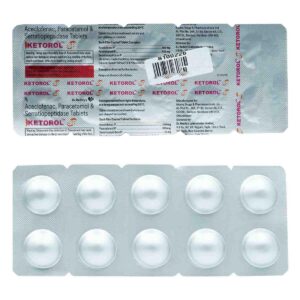KETOROLAC + SERRATIOPEPTIDASE
Ketorolac: Ketorolac, also known by its brand name Toradol, is a nonsteroidal anti-inflammatory drug (NSAID) that is used to relieve moderate to severe pain. It is typically used for short-term management of acute pain, such as pain after surgery or in cases where other pain medications may not be suitable.
The mechanism of action of ketorolac involves inhibiting the production of inflammatory chemicals called prostaglandins. By blocking the enzymes responsible for producing prostaglandins, ketorolac helps reduce pain, inflammation, and fever.
Ketorolac is available in various forms, including tablets, injections, and nasal sprays. The specific dosing depends on the route of administration and the individual patient’s needs. The oral tablets are usually taken every 4 to 6 hours, with a maximum daily dose of 40 mg for adults. The injectable form is typically administered in healthcare settings and should not be used for more than 5 days.
Like other NSAIDs, ketorolac can cause side effects. Common side effects include nausea, indigestion, stomach pain, dizziness, headache, and drowsiness. More serious side effects may occur, such as stomach ulcers, bleeding, kidney problems, and allergic reactions. It is important to use ketorolac as directed and to consult a healthcare professional if any concerning side effects occur.
Ketorolac should not be used for long-term pain management, as it carries an increased risk of adverse effects compared to other pain medications. It is contraindicated in individuals who have a history of allergic reactions to NSAIDs, active peptic ulcers, severe kidney disease, bleeding disorders, or in those who are about to undergo coronary artery bypass graft (CABG) surgery.
Patients should consult with their healthcare provider before starting ketorolac to ensure it is the appropriate medication for their condition and to determine the correct dosage and duration of treatment.
Serratiopeptidase: Serratiopeptidase, also known as serrapeptase, is an enzyme derived from the bacteria Serratia that is widely used as a medication with anti-inflammatory and fibrinolytic properties. It is primarily prescribed for its ability to reduce pain, inflammation, and swelling associated with various conditions.
The mechanism of action of serratiopeptidase involves its ability to break down proteins, particularly fibrin and other non-living tissue. By doing so, it helps to reduce inflammation and promote the healing process. It also works by improving blood circulation and reducing the viscosity of certain fluids in the body.
Serratiopeptidase is commonly used in the treatment of conditions such as sinusitis, bronchitis, arthritis, fibrocystic breast disease, and postoperative swelling. It is also used as a supplement to promote heart health and prevent blood clots.
The dosage of serratiopeptidase may vary depending on the condition being treated and the individual’s response to the medication. It is typically taken orally, and the recommended dose ranges from 10 mg to 60 mg per day. However, it is important to follow the dosage instructions provided by a healthcare professional.
As with any medication, serratiopeptidase may cause certain side effects. These can include digestive issues such as nausea, vomiting, and diarrhea. Some individuals may also experience allergic reactions, skin rashes, or changes in blood pressure. If any side effects occur or worsen, it is important to seek medical attention promptly.
It is worth noting that serratiopeptidase may interact with certain medications, so it is important to inform a healthcare professional about any other medications being taken before starting treatment. Additionally, this drug should not be used during pregnancy or breastfeeding unless specifically advised by a doctor.
Overall, serratiopeptidase is a medication with anti-inflammatory and fibrinolytic properties commonly used to reduce pain, inflammation, and swelling. It is essential to follow the prescribed dosage and consult a healthcare professional for more information and guidance.


